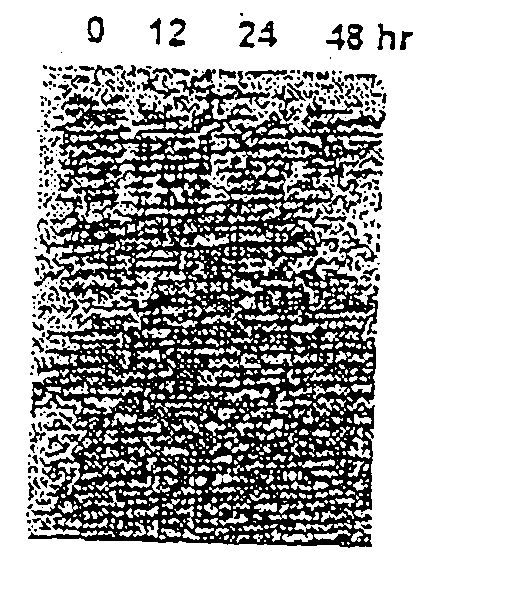Novel endonuclease of immune cell, process for producing the same and immune adjuvant using the same
a technology of endonuclease and immune cell, applied in the field of new endonuclease enzyme, can solve the problems of no further studies and knowledge regarding the processing and presentation mechanism of dna antigen, low methylation frequency of cpg dinucleotide present in bacterial dna, and non-production of autoantibody which is cross-reactive to mammalian dsdna
- Summary
- Abstract
- Description
- Claims
- Application Information
AI Technical Summary
Problems solved by technology
Method used
Image
Examples
example 1
Biosynthesis and Secretion of the Endonuclease from Immune Cell
[0060] From the fact that the enzymatic activity of DNase I is widely distributed over human tissue and body fluid, it was assumed that the enzyme possesses certain physiological in vivo functions in addition to the digestive function (Nadano D., et al (1993) Clin. Chem. 39, 448-452; and Yasuda T., et al (1993) Clin. Chim. Acta. 218, 5-16). DNase I is known to cleave internucleosomal DNA during apoptosis (Peitsch M. C., et al (1993) EMBO J. 12, 371-377). The presence of DNase I in human scrum and the biochemical properties thereof were reported (Love J. D., and Hewitt R. R.(1979) J. Biol. Chem. 254, 12588-12594; and Kishi K., et al (1990) Am. J Hum. Genet. 47, 121-126). It was taught that serum DNase I is secreted from pancreas (Love J. D., and Hewitt R. R.(1979) J. Biol. Chem. 254, 12588-12594; and Ito K. et al (1984) J. Biochem. 95, 1399-1406) but studies on the secretion from other tissues are still required. A study...
example 2
Identification of Mg2+-dependent Endonuclease Inducing Internucleosomal DNA Fragmentation
[0074] Apoptosis is defined as specific type of “cell death” such as chromatin condensation, membrane blebbing or chromatin fragmentation as various nucleosome sizes by endonuclease activity (Wyllie, A. H., et al (1984) J. Pathol. 142, 67-77; Wyllie, A. H. (1980) Nature 284, 555-556; and Kerr, J. F. R., et al (I972) Cancer. 26, 239-257).
[0075] Endonuclease activation is significantly responsible for apoptosis process (Arends, M. J., and Wyllie, A, H. (1990) J. Pathol. 136, 593-608). Many researchers suggested that there are various enzymes which involve nucleosome fragmentation. Examples of enzymes involving internucleosomal DNA fragmentation include DNase I (Peitsch M. C., et al (1993) EMBO J. 12, 71-377), DNase II (Torriglia A., (1995) J. Biol. Chem. 270, 28579-28585; and Barry M. A., and Eastman A. (1993) Arch. Biochem. Biophys. 300.440450), and NUC-18 (Wawabata, H., et al (1997) Biochem. B...
example 3
Action of Endonuclease to Foreign DNA in Immune Cell and Characterization of the Reaction Product
[0088] It was known that bacterial DNAs so far recognized as foreign agent include various structure-determining factors which are not present in mammalian DNA and that such factors are involved in the activation of immune cell (Gilkeson, G. S. et al (1995) J. Clin. Invest. 95, 1398-1402; Gilkeson, G. S. et al (1991) Clin. Immunol, Immunopathol. 59, 288-300; Messina, J. P. et al (1993) Cell. Immunol. 147, 148-157; Krieg, A. M. et al (1995) Nature 374,546-549; and Halpern, M. D. et al (1996) Cell. Immunol. 167, 72-79 ). One of the differences of mammalian DNA from bacterial DNA is that the mammalian DNA was subject to considerable CpG restriction and was selectively methylated on cytosine of CpG dinucleotide (Bird, A. P. (1995) Trends Genet. 11, 94-100; Razin, A., and Friedman, J. (1981) Prog. Nucleic Acid Res. Mol. Biol. 25, 33-52; and Han, J. et al (1994) Antisense Res. Dev. 4, 53-65)....
PUM
| Property | Measurement | Unit |
|---|---|---|
| pH | aaaaa | aaaaa |
| pH | aaaaa | aaaaa |
| pH | aaaaa | aaaaa |
Abstract
Description
Claims
Application Information
 Login to View More
Login to View More - R&D
- Intellectual Property
- Life Sciences
- Materials
- Tech Scout
- Unparalleled Data Quality
- Higher Quality Content
- 60% Fewer Hallucinations
Browse by: Latest US Patents, China's latest patents, Technical Efficacy Thesaurus, Application Domain, Technology Topic, Popular Technical Reports.
© 2025 PatSnap. All rights reserved.Legal|Privacy policy|Modern Slavery Act Transparency Statement|Sitemap|About US| Contact US: help@patsnap.com



